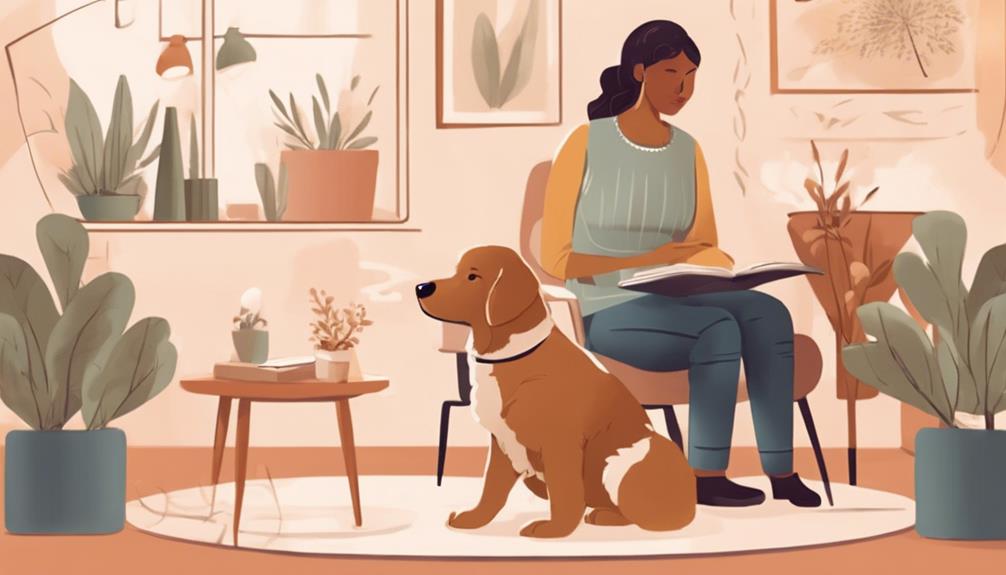11 Helpful Tips for Stress Reduction With Dog Therapy
Feeling overwhelmed by stress? Let dog therapy lead you to calm waters. Prioritize bonding with a compatible, empathetic pooch. Create a soothing haven with soft lighting and calming scents. Engage in playful activities for shared joy and relaxation. Establish clear routines for stability and trust. Practice mindfulness together for deeper connection. Get moving with your furry friend for physical and mental well-being. Shower affection to strengthen your bond and bring peace. Remember, seeking professional help is a wise step when needed. Stay tuned to uncover even more strategies to reduce stress with your loyal companion.
Benefits of Dog Therapy
Engaging in dog therapy can significantly enhance emotional well-being by fostering a sense of comfort and companionship. The unconditional love and non-judgmental nature of therapy dogs create a safe space for individuals to express their emotions freely. This emotional support plays a crucial role in improving mental well-being by reducing feelings of loneliness, anxiety, and stress.
Therapy dogs have a remarkable ability to sense when their human counterparts are feeling down or distressed. They offer a comforting presence that can help alleviate feelings of sadness and provide a source of joy during difficult times. The act of petting or playing with a therapy dog releases oxytocin, a hormone that promotes bonding and reduces stress levels. This physical interaction not only boosts mood but also helps in regulating blood pressure and heart rate.
Moreover, the presence of a therapy dog can encourage social interaction and communication. Individuals who may find it challenging to connect with others often feel more at ease engaging with a therapy dog. This can lead to improved self-esteem and a sense of belonging, which are vital for overall mental well-being. In essence, the benefits of dog therapy extend beyond mere companionship, offering a holistic approach to emotional support and mental wellness.
Choosing the Right Therapy Dog
To ensure the best match for your needs, selecting the right therapy dog involves considering factors such as temperament, training, and compatibility with your lifestyle. When choosing a therapy dog, it's crucial to evaluate the training requirements. Look for dogs that have undergone specific therapy training programs to ensure they're equipped to provide emotional support effectively. Additionally, consider the compatibility assessment between you and the dog. This includes understanding if the dog's temperament aligns with your own and if their energy levels match your lifestyle.
Emotional support is a key aspect of therapy dogs. These special animals are trained to provide comfort and companionship to help reduce stress and anxiety. When choosing a therapy dog, focus on breeds known for their nurturing and empathetic nature. Building trust between you and the dog is essential for a successful therapy partnership. Spend time getting to know the dog before making your decision, as a strong bond is vital for effective stress reduction.
Setting Up a Relaxing Environment
Creating a calming environment is essential when setting up for therapy sessions with your dog. To ensure a successful and relaxing experience, consider the following tips:
- Soft Lighting: Dimming harsh overhead lights and using soft, warm lamps can help create a serene atmosphere that promotes relaxation for both you and your furry companion.
- Comfortable Seating: Choose a cozy spot with comfortable seating arrangements where you and your dog can unwind together. Having plush cushions or blankets can enhance the comfort level of the space.
- Soothing Music: Playing gentle, calming music in the background can contribute to the overall ambiance and help set a tranquil mood for your therapy session.
- Aromatherapy: Consider using essential oils like lavender or chamomile to infuse the air with soothing scents that promote relaxation and reduce stress levels for both you and your dog.
Incorporating Playtime for Stress Relief
When looking to reduce stress through playtime with your dog, consider incorporating interactive activities that promote bonding and relaxation. Interactive games are a fantastic way to engage with your furry friend while also relieving stress. Games like tug-of-war, hide-and-seek, or even teaching them new tricks can provide mental stimulation for both you and your dog. These activities not only keep your dog physically active but also strengthen the emotional connection between you two.
Outdoor adventures are another great way to incorporate playtime for stress relief. Taking your dog for a walk in the park, hiking on a trail, or even playing fetch in the backyard can help both of you unwind and enjoy the fresh air. The change of scenery and physical activity can work wonders in reducing stress levels for both you and your canine companion.
Establishing Routine and Boundaries
Establishing a consistent routine and setting clear boundaries with your dog can greatly contribute to reducing stress and fostering a harmonious relationship. Daily routines provide structure and predictability for both you and your furry friend, helping to create a sense of stability and security.
Here are some tips to help you establish boundaries and routines effectively:
- Set Clear Rules: Establishing clear rules and boundaries from the beginning will help your dog understand what's expected of them. Consistency is key in reinforcing these rules.
- Create a Daily Schedule: Dogs thrive on routine. Set a daily schedule for feeding, walks, playtime, and rest. This routine helps your dog know what to expect and reduces anxiety.
- Use Positive Reinforcement: When your dog follows the rules and boundaries you've set, reward them with praise, treats, or extra playtime. Positive reinforcement encourages good behavior.
- Provide a Safe Space: Designate a specific area in your home where your dog can retreat to when they need some alone time. This safe space can be a crate, a cozy bed, or a quiet corner.
Practicing Mindfulness With Your Dog
To enhance your bond with your furry companion, embrace mindfulness practices that center around being present and attuned to your dog's needs and emotions. Mindful walks are an excellent way to engage in this practice.
As you walk with your dog, focus on the sensations around you – the feeling of the ground beneath your feet, the sounds of nature, and the sight of your dog exploring. Allow yourself to let go of distractions and truly immerse yourself in the present moment. This shared experience can deepen your connection and bring a sense of peace and relaxation to both you and your dog.
In addition to mindful walks, consider incorporating breathing exercises and meditation into your routine with your dog. Find a quiet space where you and your furry friend can sit comfortably. Take deep, slow breaths, and observe how your dog's presence can have a calming effect on you. Dogs are incredibly attuned to human emotions, and by practicing mindfulness together, you can create a harmonious environment that benefits both of you.
Engaging in Physical Activities Together

Engage in physical activities with your furry companion to strengthen your bond and promote both of your well-being. Spending active time together not only benefits your physical health but also enhances the emotional connection you share with your dog. Here are some ways you can engage in physical activities with your canine friend:
- Outdoor Adventures: Take your dog on hikes, runs, or even a game of fetch at the park. Exploring the outdoors together can be invigorating for both of you and provide a change of scenery from your daily routine.
- Indoor Games: When the weather doesn't permit outdoor activities, opt for indoor games like hide-and-seek or setting up an obstacle course. These games stimulate your dog's mind and keep them physically active without leaving the comfort of your home.
- Agility Training: Set up a mini agility course in your backyard or a spacious area indoors. Teaching your dog to navigate obstacles can be a fun and engaging way to bond while keeping them physically fit.
- Swimming: If your dog enjoys the water, consider taking them for a swim. Swimming is a low-impact exercise that's easy on the joints and can be a refreshing activity, especially during hot weather.
Using Affection and Bonding Time
As you deepen your connection through physical activities, incorporating affectionate moments and bonding time with your furry companion can further strengthen your relationship. Bonding exercises play a crucial role in reducing stress and anxiety. Spending quality time with your dog can create a sense of comfort and security. Engage in activities that promote bonding, such as cuddling on the couch, playing interactive games, or simply going for a peaceful walk together. These moments not only enhance your bond but also provide a calming presence that can help alleviate stress.
Affection is a powerful tool in fostering a strong connection with your dog. Take the time to show your furry friend love and affection through gentle petting, belly rubs, and verbal praise. Dogs thrive on physical touch and positive interactions, which can boost their mood and yours. The act of petting a dog has been shown to release oxytocin, a hormone that promotes bonding and reduces stress levels for both you and your canine companion.
Incorporating bonding time into your daily routine can greatly benefit your overall well-being. Make time each day to engage in activities that strengthen your relationship and deepen your connection with your dog. Remember, your furry friend isn't just a pet but a loyal companion who can provide endless support and love during times of stress.
Seeking Professional Guidance When Needed

If you find yourself overwhelmed by stress or struggling to cope with your emotions, consider reaching out to a professional for guidance and support. Seeking help is a brave and proactive step towards managing your stress levels and improving your mental well-being.
Here are some tips to guide you in finding the support you need:
- Research Therapy Options: Look into different therapy options available in your area, such as cognitive-behavioral therapy, psychotherapy, or even animal-assisted therapy. Each type of therapy offers unique benefits, so finding the right fit is crucial for your healing journey.
- Consider Support Groups: Joining a support group can provide you with a sense of community and understanding. Interacting with others who are going through similar experiences can be comforting and empowering.
- Consult with a Mental Health Professional: Schedule an appointment with a mental health professional, such as a therapist, counselor, or psychologist. These experts are trained to help you navigate your feelings and develop healthy coping mechanisms.
- Explore Online Resources: If traditional therapy settings feel daunting, consider exploring online therapy platforms or mental health apps. These resources offer convenience and accessibility, allowing you to receive support from the comfort of your own home.
Monitoring Your Stress Levels
Monitoring your stress levels is essential for maintaining your overall well-being and preventing burnout. By keeping tabs on how you're feeling, you can identify patterns and triggers that may be causing stress in your life. One effective way to monitor your stress levels is to keep a stress journal. In this journal, jot down daily stressors, your emotional responses, and any stress management techniques you use. This will help you track progress and gain insights into what works best for you.
In addition to a stress journal, consider using technology to assist you in monitoring your stress levels. There are various apps available that can help you log your stress levels, mood changes, and even physical symptoms associated with stress. These tools can provide you with a comprehensive overview of your stress patterns over time, enabling you to make informed decisions about your stress management strategies.
Celebrating Progress and Success

To acknowledge your achievements and milestones, take a moment to reflect on how far you've come in managing your stress. It's important to recognize the progress you've made and celebrate the successes, no matter how small they may seem. Here are some tips to help you appreciate and acknowledge your journey towards a less stressful life:
- Reflect on Your Growth: Spend some time thinking about the ways in which you have grown and evolved in your stress management techniques. Recognize the positive changes you have made.
- Celebrate Small Wins: Don't overlook the small victories along the way. Whether it's successfully using a relaxation technique or taking a break when needed, every little step counts.
- Share Your Achievements: Share your progress with someone you trust. Talking about your successes can reinforce your efforts and provide a sense of pride.
- Reward Yourself: Treat yourself for reaching milestones in your stress reduction journey. It could be something simple like a relaxing bath or a walk with your furry companion.
Frequently Asked Questions
Can Any Breed of Dog Be a Therapy Dog?
Yes, any breed of dog can potentially become a therapy dog. However, training requirements and behavior evaluation are crucial to ensure they have the right personality traits.
The certification process involves thorough assessments to ensure that the dog is suitable for therapy work. Remember, it's not just about the breed, but also about the individual dog's temperament and behavior.
Proper training and assessment are key to successful therapy dog certification.
How Do I Know if My Dog Is Stressed Out?
If you're wondering how to tell if your dog is stressed out, look for signs like:
- Excessive panting,
- Pacing,
- Shaking,
- Avoiding eye contact.
Behavior indicators may include increased:
- Barking,
- Whining,
- Destructive behavior.
Pay attention to changes in:
- Appetite
- Sleep patterns too.
Your furry friend relies on you to notice these cues and provide comfort. Be attuned to their needs and seek help if you notice any concerning signs of stress.
Should I Use Treats to Reward My Therapy Dog?
Yes, you should use treats to reward your therapy dog. Positive reinforcement through treats is an effective way to encourage good behavior and strengthen the bond between you and your furry companion.
If you prefer alternatives to treats, consider using praise or favorite toys as rewards. These training techniques not only help your dog learn but also provide valuable bonding opportunities that can enhance your therapy sessions together.
What if My Dog Doesn't Like Physical Activities?
If your dog doesn't like physical activities, focus on mental stimulation with indoor games. Try interactive toys or puzzle feeders to keep them engaged.
You can also incorporate relaxation techniques such as gentle massages or mental exercises like scent games. It's important to respect your dog's preferences and find activities that bring them joy and relaxation.
Can Therapy Dogs Help With Specific Mental Health Conditions?
Yes, therapy dogs can provide valuable support for specific mental health conditions. They offer anxiety relief by providing comfort and emotional support.
For individuals struggling with depression, therapy dogs can help alleviate feelings of loneliness and provide companionship. Their presence can improve mood and overall well-being.
Therapy dogs are trained to offer unconditional love and understanding, making them excellent companions for those dealing with various mental health challenges.
Conclusion
Remember, incorporating dog therapy into your stress reduction routine can have numerous benefits for your mental and emotional well-being.
By choosing the right therapy dog, creating a relaxing environment, and incorporating playtime and affection, you can help alleviate stress and improve your overall quality of life.
Remember to seek professional guidance when needed, monitor your stress levels, and celebrate your progress and successes along the way.
You deserve to feel calm, supported, and happy.
